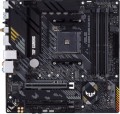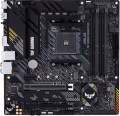M.2 version
The version of the M.2 interface determines both the maximum data transfer rate and the supported devices that can be connected via physical M.2 connectors (see the corresponding paragraph).
The version of the M.2 interface in the specifications of motherboards is usually indicated by the number of connectors themselves and by the PCI-E revision provided for in each of them. For example, the entry “3x4.0” means three connectors capable of supporting PCI-E 4.0; and the designation “2x5.0, 1x4.0” means a trio of connectors, two of which support PCI-E 4.0, and another one supports PCI-E 5.0.
CrossFire (AMD)
Motherboard support for
AMD's Crossfire technology.
This technology allows you to connect several separate AMD graphics cards to a PC at once and combine their computing power, respectively increasing the system's graphics performance in specific tasks. Accordingly, this feature means that the "motherboard" is equipped with at least two slots for video cards — PCI-E 16x; in general, Crossfire allows up to 4 separate adapters to be connected.
Such functionality is especially important for demanding games and "heavy" tasks like 3D rendering. However, note that in order to use several video cards, this possibility must also be provided in the application running on the computer. So in some cases, one powerful video adapter is more preferable than several relatively simple ones with the same total amount of VRAM.
A similar technology from NVIDIA is called SLI (see below). Crossfire differs from it mainly in three points: the ability to combine video adapters with different models of graphics processors (the main thing is that they are built on the same architecture), no need for additional cables or bridges (video cards interact directly via the PCI-E bus) and somewhat lower cost (allowing the use of this technology even in low-cost "motherboards"). Thanks to the latter, almost all motherboards with SLI also support Crossfire, but not vice versa.
DisplayPort version
The version of the DisplayPort interface (see above) installed on the motherboard.
— v.1.2. The oldest version in use today (2010). It was in it that 3D support first appeared, the ability to work with the miniDisplayPort connector, as well as the option of connecting several screens in series to one port (daisy chain). The maximum resolution fully supported by v.1.2 is 5K at 30 fps, with some limitations, 8K video is also supported. And the v.1.2a update, introduced in 2013, added compatibility with the FreeSync technology used in AMD graphics cards.
— v.1.3. An update to the DisplayPort standard released in 2014. Thanks to the increase in bandwidth, it was possible to provide full support for 8K video (at 30 fps), and in 4K and 5K standards, increase the maximum frame rate to 120 and 60 fps, respectively. Another key update was the Dual-mode function, which provides compatibility with HDMI and DVI interfaces through the simplest passive adapters.
— v.1.4. The most recent version of the widely used. The bandwidth has been further increased (almost doubled compared to v.1.2, which allowed, albeit with some limitations, to transmit 4K and 5K video at up to 240 fps and 8K at up to 144 fps. In addition, Support for a number of special features has been added, including HDR10, and the maximum number of simultaneously transmitted audio channels has increased to 32.
Audiochip
The model of the audio chip (a module for processing and outputting sound) installed on the motherboard. Data on the exact name of the sound chip will be useful when looking for detailed information about it.
Modern "motherboards" can be equipped with fairly advanced audio modules, with high sound quality and extensive features, which makes them suitable even for gaming and multimedia PCs (although professional audio work will still most likely require a separate sound card). Here are the most popular modern audio chips:
Realtek ALC887,
Realtek ALC892,
Realtek ALC1150,
Realtek ALC1200,
Realtek ALC1220,
Realtek ALC4050,
Realtek ALC4080,
Supreme FX.
Wi-Fi
Bluetooth
The motherboard has its own
Bluetooth module, which eliminates the need to purchase such an adapter separately. Bluetooth technology is used for direct wireless connection of a computer with other devices — mobile phones, players, tablets, laptops, wireless headphones, etc.; connectivity options include both file sharing and external device control. The Bluetooth connection range is up to 10 m (in later standards — up to 100 m), while the devices do not have to be in the line of sight. Different versions of Bluetooth (at the end of 2021, the latest of which is
Bluetooth v 5) are mutually compatible in terms of basic functionality and have all sorts of differences.
LAN controller
Model of the LAN controller installed in the motherboard.
The LAN controller provides data exchange between the card and the network port(s) of the computer. Accordingly, both general characteristics and individual features of the network functionality of the "motherboard" depend on the characteristics of this module: support for special technologies, connection quality in case of unstable communication, etc. Knowing the model of the LAN controller, you can find detailed data on it — including including practical reviews; this information is rarely needed by the average user, but it can be useful for online game enthusiasts and for some specific tasks.
Thus, the LAN controller model is specified mainly in cases where it is a rather advanced solution that is noticeably superior to standard models. Such solutions are currently produced mainly under the brands
Intel(middle level),
Realtek(relatively simple models),
Aquntia and
Killer(mostly advanced solutions).
CPU Fan 4-pin
A four-pin connector used to connect a processor cooling fan. The first contact in it corresponds to the black wire of the cooler — it is the "ground" or minus of the power supply. The second contact is the plus of the power supply (yellow or red cooler wire). The third one is involved in measuring the rotation speed of the impeller (green or yellow fan wire). The fourth pin, corresponding to the blue wire, receives control signals from the PWM controller to adjust the cooler rotation speed depending on the temperature of the processor.
CPU/Water Pump Fan 4-pin
A four-pin connector for connecting a water cooling pump fan. It can also be used to turn on an additional CPU cooler.

